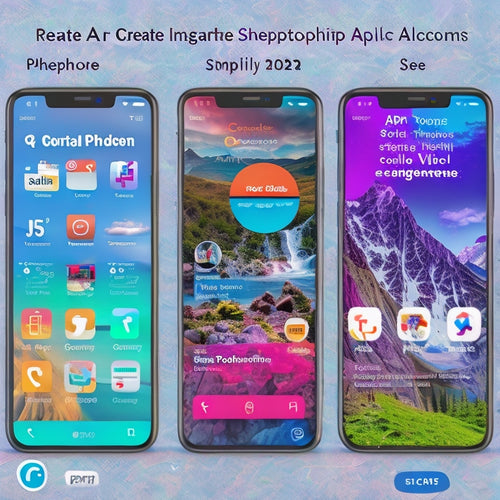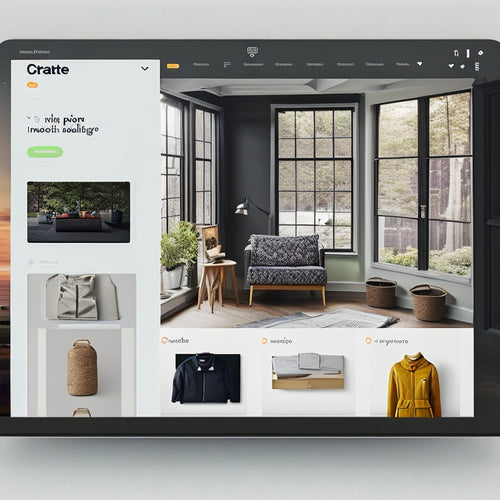
Create and Sell Digital Products With Ease
Share
To create and sell digital products with ease, start by selecting a scalable platform that integrates with payment gateways and marketing tools. Craft engaging content that resonates with your target audience, using interactive elements and visuals to break up text. Design a user-friendly interface that's optimized for various devices. Develop a sales strategy that highlights your product's unique selling points, and target your audience through email marketing and social media advertising. By following these steps, you'll be well on your way to creating a profitable online business - and with the right tools and strategies, you'll reveal even more opportunities for growth and success.
Key Takeaways
• Choose a scalable and customizable platform that integrates with payment gateways and marketing tools for seamless sales.
• Craft engaging content that resonates with your target audience through clear narratives, interactive activities, and relatable examples.
• Design a user-friendly interface with clear typography, visual hierarchy, and interactive elements to enhance learner participation.
• Develop effective sales and marketing strategies by identifying unique selling points, crafting compelling messaging, and leveraging targeted email campaigns and social media advertising.
• Continuously track performance, collect customer feedback, and analyze data to refine your digital product and improve customer experience.
Choosing the Right Platform
When deciding on a platform to host and sell your digital products, you'll want to ponder factors such as scalability, customization options, and integrations with payment gateways and marketing tools.
A thorough platform comparison will help you identify the best fit for your business needs.
Payment integrations are essential, as they'll determine how seamlessly transactions are processed. Look for platforms that offer flexible payment options and easy integration with popular gateways like Stripe or PayPal.
Beyond payment integrations, consider the level of customer support offered. You'll want a platform that provides reliable, 24/7 assistance to guarantee any issues are quickly resolved.
Customization options are also vital, as they'll allow you to tailor your storefront and product pages to your brand. A customizable platform will help you create a seamless user experience, increasing the chances of conversion.
Creating Engaging Course Content
To create engaging course content, you'll need to craft a clear, well-structured narrative that resonates with your target audience and effectively conveys your message. This means breaking down complex topics into bite-sized chunks, using relatable anecdotes, and incorporating real-life examples that illustrate key concepts.
Don't forget to add interactive activities, such as quizzes, polls, and discussions, to encourage learner participation and engagement. Engaging visuals, like infographics, videos, and images, can also help to break up text-heavy content and make your course more dynamic.
When crafting your content, focus on providing actionable insights and practical takeaways that learners can apply to their own lives or businesses. Avoid using overly technical jargon or vague concepts that might confuse or intimidate your audience. Instead, use clear, concise language that's easy to understand and relate to.
Designing a User-Friendly Interface
With your engaging course content in place, you'll now want to wrap it in a user-friendly interface that's intuitive, visually attractive, and easy to navigate, allowing learners to focus on absorbing your valuable information rather than struggling to find it. A well-designed interface is vital to creating a seamless learning experience, and it's crucial to get it right.
Here are some key elements to keep in mind:
-
Clear typography: Use a clear, readable font to make sure learners can easily consume your content.
-
Visual hierarchy: Organize your content using headings, subheadings, and white space to establish a clear visual flow.
-
Interactive elements: Include interactive features like quizzes, polls, and discussion forums to keep learners engaged.
-
Consistent design: Maintain a consistent design language throughout your course to create a cohesive look and feel.
-
Responsive design: Guarantee your course is optimized for various devices and screen sizes to accommodate different learning preferences.
Developing a Sales Strategy
You've invested time and effort in creating a high-quality digital product, so now it's pivotal to develop a sales strategy that effectively communicates its value to potential customers. A well-planned sales strategy will help you reach your target audience and drive sales.
To start, identify your unique selling points and craft compelling messaging that resonates with your audience. Next, decide on the sales channels that will work best for your product. Email marketing, for instance, is an effective way to nurture leads and encourage purchases. You can create targeted email campaigns that highlight the benefits of your product and offer exclusive promotions.
Social media advertising is another powerful tool that can help you reach a wider audience. By creating targeted ads on platforms like Facebook and Instagram, you can drive traffic to your website and increase conversions. By combining these strategies, you'll be well on your way to developing a sales strategy that drives real results.
Building a Targeted Audience
Having defined a sales strategy, it's now imperative to pinpoint the ideal customers who'll benefit most from your digital product and craft a buyer persona that guides your marketing efforts. This targeted audience will be the foundation of your marketing strategy, helping you create content that resonates with them and ultimately drives sales.
To build this audience, consider the following strategies:
-
Leverage social media marketing to reach your target demographic and build brand awareness
-
Utilize email outreach to connect with potential customers and nurture leads
-
Partner with influencers in your niche to expand your reach and credibility
-
Collaborate on content with other industry experts to build relationships and trust
-
Analyze your competition's audience to identify gaps in the market and opportunities to differentiate yourself
Pricing and Packaging Options
Determine the best pricing strategy for your digital product by analyzing factors such as production costs, target audience, competition, and revenue goals. You want to set a price that's attractive to your audience while ensuring you make a profit.
When it comes to packaging options, you have several choices to evaluate. Here are a few popular ones:
| Option | Description | Benefits |
|---|---|---|
| Basic | Single digital product | Simple, easy to manage |
| Premium | Bundle of related products | Increased value, higher revenue |
| Custom | Bundling with customizing options | Flexibility, personalized experience |
Bundling techniques can help you increase revenue and provide more value to your customers. Offering customizing options can also make your product more appealing to a wider range of customers. By combining these strategies, you can create a pricing and packaging plan that meets your business goals and resonates with your target audience.
Creating a Sales Page
Creating a captivating sales page is an essential step in selling your digital product, as it's often the first point of contact between your potential customer and your offer. This is where you'll convert browsers into buyers, so it's vital to get it right.
To maximize sales page optimization and boost conversion rates, focus on the following key elements:
-
Clear headlines: Grab attention with bold, descriptive headlines that communicate the value of your product.
-
Compelling visuals: Use high-quality images or videos that showcase your product's features and benefits, reinforcing your brand identity.
-
Social proof: Highlight customer testimonials, ratings, and reviews to build trust and credibility.
-
Concise copy: Write clear, concise, and scannable content that addresses pain points and emphasizes the benefits of your product.
-
Prominent calls-to-action: Make it easy for customers to take action with prominent, actionable buttons that stand out on the page.
Delivering and Supporting Products
You've successfully sold your digital product, and now it's time to ensure seamless delivery and ongoing support to maintain customer satisfaction and foster long-term loyalty. This illustrates the importance, as it directly influences your reputation and future sales.
To guarantee a smooth delivery process, consider using digital product delivery platforms that automate the process, sending your product to customers instantly. This eliminates the risk of delays and lost files.
For ongoing support, create a knowledge base or FAQ section on your website, providing customers with easy access to answers and troubleshooting tips. This reduces the number of support requests and allows your team to focus on more intricate issues.
Encourage customer feedback to identify areas for improvement and implement product updates accordingly. This showcases your dedication to continuous improvement and enhances the overall customer experience.
Tracking and Analyzing Results
With digital product sales underway, monitoring key performance metrics is essential to gauge the success of your product and identify areas for optimization. You need to track the right metrics to understand your product's performance and make data-driven decisions.
Here are the vital metrics to focus on:
-
Conversion rates: Track the percentage of visitors who complete a desired action, such as purchasing your product.
-
Customer feedback: Collect and analyze feedback to identify areas for improvement and optimize your product.
-
Revenue and profit margins: Monitor your product's revenue and profit margins to make sure you're meeting your financial goals.
-
Customer acquisition costs: Track the cost of acquiring new customers to optimize your marketing strategies.
-
Data visualization: Use tools like charts and graphs to visualize your data and identify trends and patterns.
Frequently Asked Questions
Can I Sell Digital Products if I'm Not a Tech Expert?
You don't need to be a tech expert to sell digital products; focus on developing effective marketing strategies, exploring design options, and understanding pricing models to connect with your target audience.
How Do I Protect My Digital Product From Piracy?
You shield your intellectual gem from thieves by implementing robust copyright protection, discreet watermarking, and secure download links fortified with encryption, ensuring your valuable digital asset remains yours alone to profit from.
Can I Update My Digital Product After It's Launched?
You can absolutely update your digital product after launch, incorporating customer feedback and refining features. Implement version control to track changes, ensuring customer satisfaction and a superior product that stays ahead of the competition.
Do I Need to Offer Refunds or Guarantees?
"As you chart your digital empire, you'll need to navigate refund policies, ensuring customer satisfaction and shielding yourself from legal landmines. Craft a clear, customer-centric approach that balances quality with risk, and you'll be golden."
How Do I Handle Customer Support and Inquiries?
You'll maintain a reputation for excellence by responding to customer inquiries within 24-48 hours, and having a clear plan for handling difficult customers, ensuring timely resolutions that showcase your brand's commitment to superior support.
Related Posts
-
Unlocking the Power of Internal Link Flow and Topical Authority With Topical Map
This article explores the concept of unlocking the power of internal link flow and topical authority with the use of...
-

Top Social Media Apps for Shopify in 2023: Boost Your Brand's Reach and Sales
This article explores the top social media apps for Shopify in 2023 and their significance in enhancing brand reach ...
-

What Is the Best Email Platform for Shopify
This article aims to provide an informative and objective analysis of the best email platform for Shopify. It will e...

